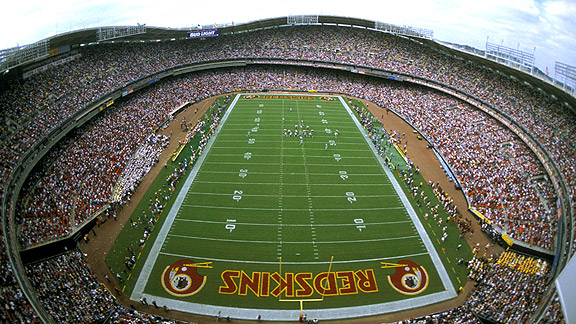When D.C. United ends its 2017 home season on Oct. 22, it will mark the end of an era for the MLS team–and the end of an era in stadium history, one that includes plenty of football history.
D.C. Stadium opened on October 1, 1961, with the Washington Redskins hosting the New York Giants in a game that attracted 37,767 fans to the new facility. While that number may seem small today, it was a huge improvement to how the Redskins drew at their previous home, Griffith Stadium. In terms of fan amenities, it was a huge step up from the seemingly ancient home of the Washington Senators, which opened in 1911. This was a new era in Washington, and a thoroughly modern stadium was part of that new era.
How modern? When D.C. Stadium opened (it would be renamed Robert F. Kennedy Stadium, or RFK Stadium, in 1969), it was the first multiuse stadium built explicitly for pro baseball and pro football. Though NFL teams had played out of stadiums owned by pro baseball teams–Yankee Stadium, Wrigley Field, Tiger Stadium, Forbes Field, the Polo Grounds–the design in these ballparks was always baseball first, with football a secondary concern, and pro football even less of a consideration.
With RFK Stadium, however, the design from George L. Dahl and Osborn Engineering took a quantum leap forward in treating baseball and football equally. In a move copied by designers of other cookie-cutter stadiums in New York City, St. Louis, Pittsburgh, Oakland, Philadelphia and Atlanta, a circular design allowed for the movement of seating areas depending on the event. In the case of RFK Stadium, the left-field bleachers were moved on tracks, and those bleachers became the equivalent of a stadium bouncy house. Get enough fans jumping around, and the whole stadium shook.
While cookie-cutter stadiums from the 1960s and 1970s were derided by fans as failing to provide decent football or baseball experiences, that wasn’t true at RFK Stadium. Maybe it’s because the stadium bowl wasn’t a true circle, that the curvy roofline provided some visual interest, or maybe what was cutting edge in 1961 aged very well into the 1980s and 1990s, but RFK Stadium never seemed as generic as, say, Three Rivers Stadium.
That second-gen Senators team only lasted in D.C. until the end of the 1971 season, making the Redskins the prime tenant. That year saw the appointment of George Allen as GM and head coach, completing the rebuilding effort launched by the late Vince Lombardi and taking the team to the next level, complete with a Super Bowl appearance in 1973. RFK Stadium became a very hot ticket in D.C.–and the team grew even more popular in the 1980s during the era of Joe Gibbs, Joe Theismann and the Hogs. A Redskins game, even a bad one, was a visceral experience with the stadium literally rocking. It’s an environment that the team has never been able to replicate at FedEx Field.
Today, RFK Stadium is a shadow of its former self, with plenty of visible rust, skeevy concrete and limited concessions. There’s little surprise in D.C. United’s pursuit of a more modern facility; MLS fans crave dedicated supporter stands, plenty of club space and different seating options throughout the stadium-all things not possible at RFK Stadium. But the folks in D.C. are used to teams abandoning RFK Stadium: the second iteration of the Washington Senators left in 1971, and the Redskins left after the 1996 season. Since then, D.C. United has been the stadium’s main tenant, but the plan is to play the 2018 season and beyond at Audi Field.
Currently there are no firm deadlines for tearing down RFK Stadium, but most consider it inevitable, as undoubtedly a better use for the site will be found. (Indeed, it’s already being floated as the site for a new Redskins stadium.) While it’s not the last stadium of an era–the Oakland Coliseum may live on longer thanks to delays with a new Las Vegas NFL facility–losing it will close an interesting chapter in stadium history. Yes, cookie-cutter stadiums were not really loved in architectural terms, as serving two masters proved to be an insurmountable problem. But the unique design of RFK Stadium for its era makes it a notable facility.
This article first appeared in the weekly Football Stadium Digest newsletter. Are you a subscriber? It’s free, and you’ll see features like this before they appear on the Web. Go here to subscribe to the Football Stadium Digest newsletter.

